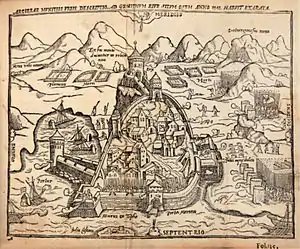Algiers expedition (1541)
The 1541 Algiers expedition occurred when Charles V of the Holy Roman Empire attempted to lead an amphibious attack against the Ottoman Empire's stronghold of Algiers, in modern Algeria. Inadequate planning, particularly against unfavourable weather, led to the failure of the expedition.
| Algiers expedition | |||||||
|---|---|---|---|---|---|---|---|
| Part of the Ottoman-Habsburg wars | |||||||
 Siege of Algiers in 1541. Engraving of 1555. | |||||||
| |||||||
| Belligerents | |||||||
|
|
| ||||||
| Commanders and leaders | |||||||
|
Charles V Navy: Andrea Doria Army: Duke of Alba[3] Including: |
| ||||||
| Strength | |||||||
|
Total of 80 galleys Total of 500 ships[3] 12,000 sailors[3] 24,000 soldiers[3] Including: |
800 soldiers 5,000 Moors[3][4] | ||||||
| Casualties and losses | |||||||
|
300 officers killed[3] 17,000 men killed[3] 17 galleys sunk 130 carracks sunk[3] | Light | ||||||
Background
Algiers had been under the control of the Ottoman Emperor Suleiman the Magnificent since its capture in 1529 by Barbarossa. Barbarossa had left Algiers in 1535 to be named High Admiral of the Ottoman Empire in Constantinople, and was replaced as governor by Hassan Agha, a eunuch and Sardinian renegade.[3] Hassan had in his service the well-known Ottoman naval commanders Dragut, Sālih Reïs, and Sinān Pasha.[3]
Charles V made considerable preparations for the expedition, wishing to obtain revenge for the recent siege of Buda,[5] However the Spanish and Genoese fleets were severely damaged by a storm, forcing him to abandon the venture.[6][7]
Expedition
Charles V embarked very late in the season, on 28 September 1541, delayed by troubles in Germany and Flanders.[3][8] The fleet was assembled in the Bay of Palma, at Majorca.[3] It had more than 500 sails and 24,000 soldiers.[3]
After enduring difficult weather, the fleet only arrived in front of Algiers on 19 October.[9] The most distinguished Spanish commanders accompanied Charles V on this expedition, including Hernán Cortés, the conqueror of Mexico, though he was never invited to the War Council.[8]
Troops were disembarked on 23 October, and Charles established his headquarters on a land promontory surrounded by German troops.[8] German, Spanish, and Italian troops, accompanied by 150 Knights of Malta, began to land while repelling Algerine opposition, soon surrounding the city, except for the northern part.[3]
The fate of the city seemed to be sealed, however the following day the weather became severe with heavy rains. Many galleys lost their anchors and 15 were wrecked onshore. Another 33 carracks sank, while many more were dispersed.[10] As more troops were attempting to land, the Algerines started to make sorties, slaughtering the newly arrived. Charles V was surrounded, and was only saved by the resistance of the Knights of Malta.[11]
Andrea Doria managed to find a safer harbour for the remainder of the fleet at Cape Matifu, 5 miles east of Algiers. He enjoined Charles V to abandon his position and join him in Matifu, which Charles V did with great difficulty.[12] From there, still oppressed by the weather, the remaining troops sailed to Bougie, still a Spanish harbour at that time. Charles could only depart for the open sea on 23 November.[13] Throwing his horses overboard, Charles abandoned his army and sailed home.[14] He finally reached Cartagena, in southeast Spain, on 3 December.[15]
Losses amongst the invading force were heavy with 17 galleys and 130 carracks lost, plus large numbers of sailors and soldiers.[16] A Turkish chronicler confirming that the Berber tribes were massacring the 12,000 men of invading forces[17] So many of Charles' troops were taken captive that there was a glut of slaves on the market in Algiers, so that 1541 was said to be the year when Christians were sold for the price of an onion per head.[18]
Aftermath
The disaster considerably weakened the Spanish, and Hassan Agha took the opportunity to attack Mers-el-Kebir, the harbour of the Spanish base of Oran, in July 1542.[19]
Notes
- Phillip C. Naylor (5 September 2006). Historical Dictionary of Algeria. Scarecrow Press. p. 157. ISBN 978-0-8108-6480-1.
- Berber Government: The Kabyle Polity in Pre-colonial Algeria, p191
- The Story of the Barbary Corsairs by Stanley Lane-Poole p.114ff
- Handbook for travellers in Algeria and Tunis, Algiers, Oran, Constantine ... by John Murray (Firm),Sir Robert Lambert Playfair p.38
- Garnier, p.201
- European warfare, 1494–1660 by Jeremy Black p.177
- E.J. Brill's first encyclopaedia of Islam, 1913–1936 by Martijn Theodoor Houtsma p.258
- Garnier, p.202
- Garnier, p.203
- Garnier, p.204ff
- Garnier, p.204
- Garnier, p.205
- Garnier, p.207
- Roger Crowley, Empires of the Sea, faber and faber 2008 p.73
- Garnier, p.206
- Garnier, p.208
- Garcés, María Antonia (2005). Cervantes in Algiers: A Captive's Tale (illustrated, revised ed.). Vanderbilt University Press. p. 24. ISBN 0826514707. Retrieved 17 November 2015.
- Roger Crowley, Empires of the Sea, faber and faber 2008 p. 73
- A history of the Maghrib in the Islamic period by Jamil M. Abun-Nasr p.155 ff
.png.webp)